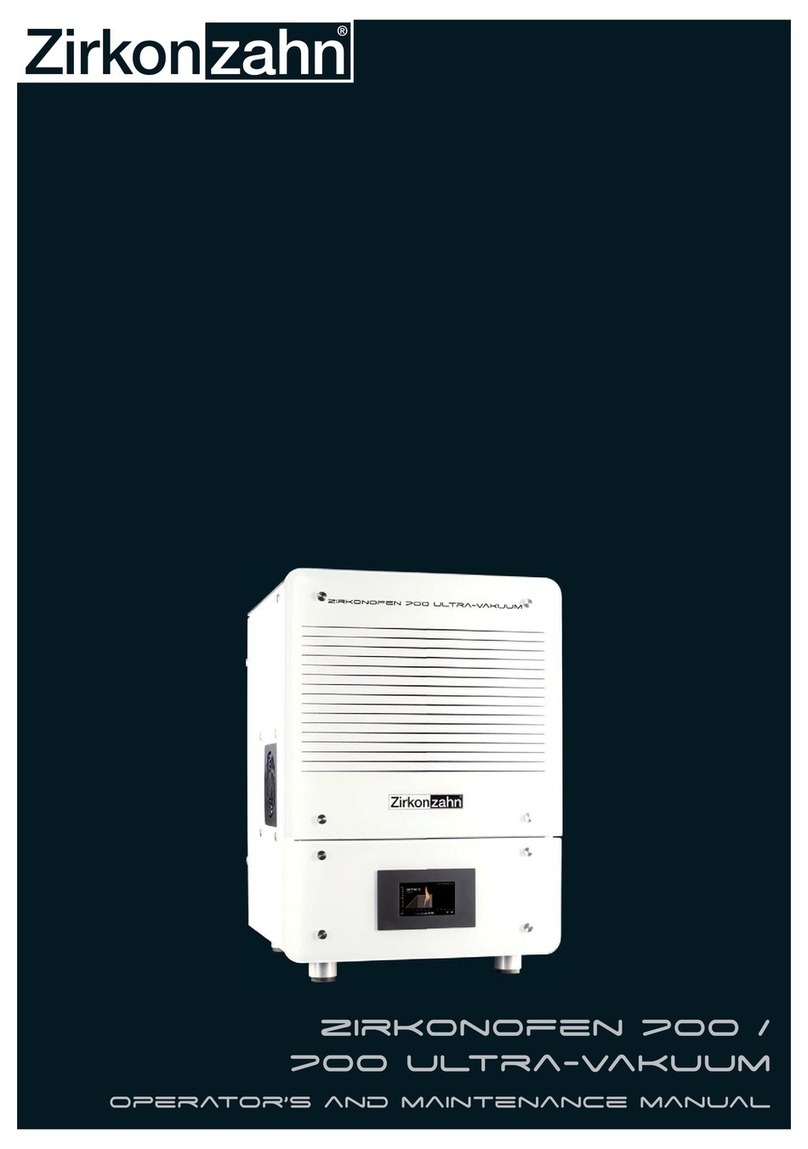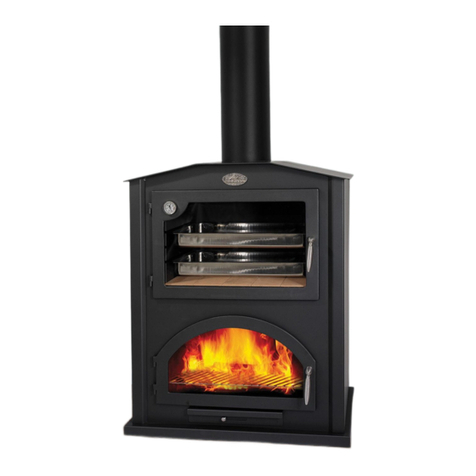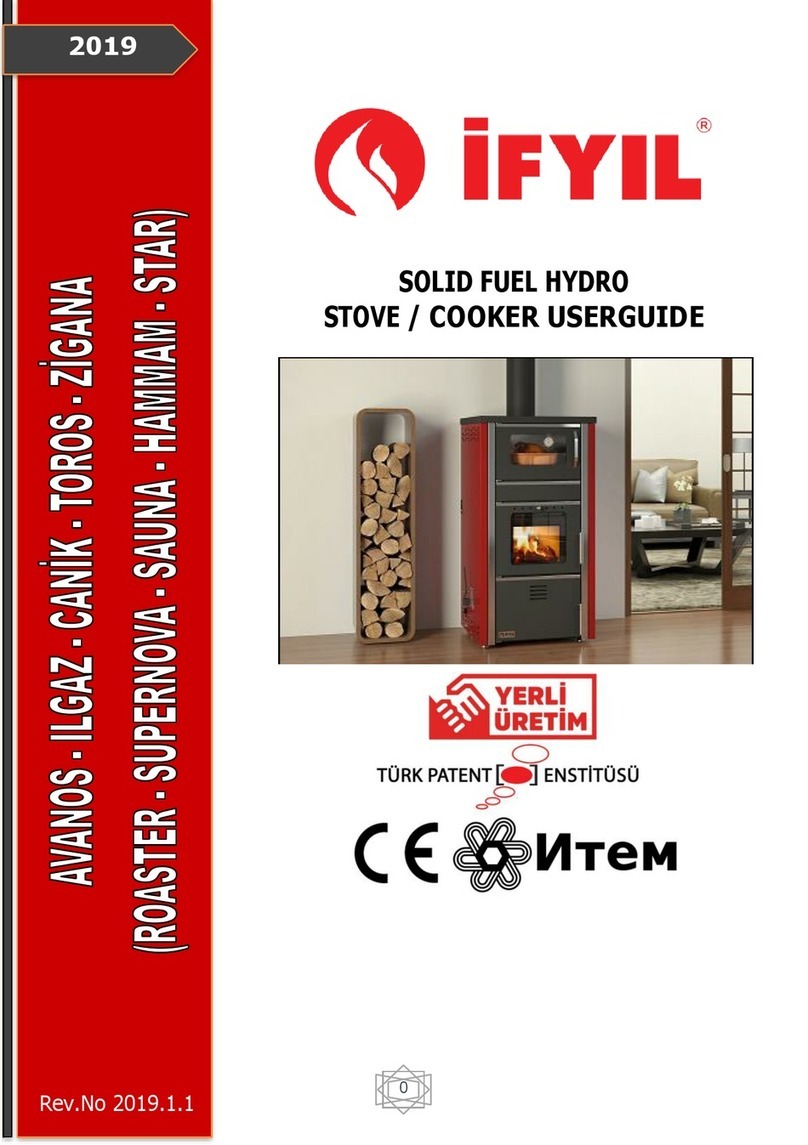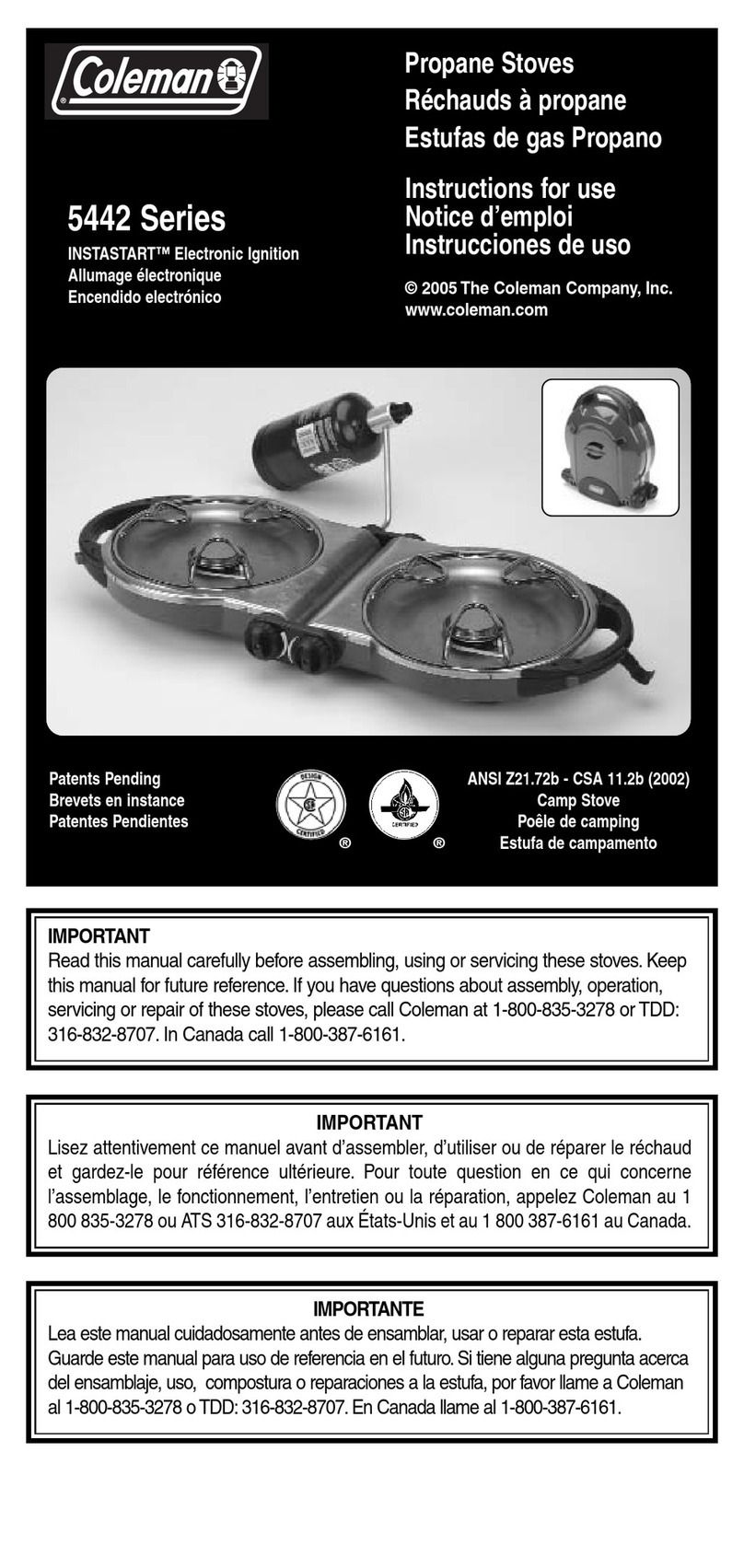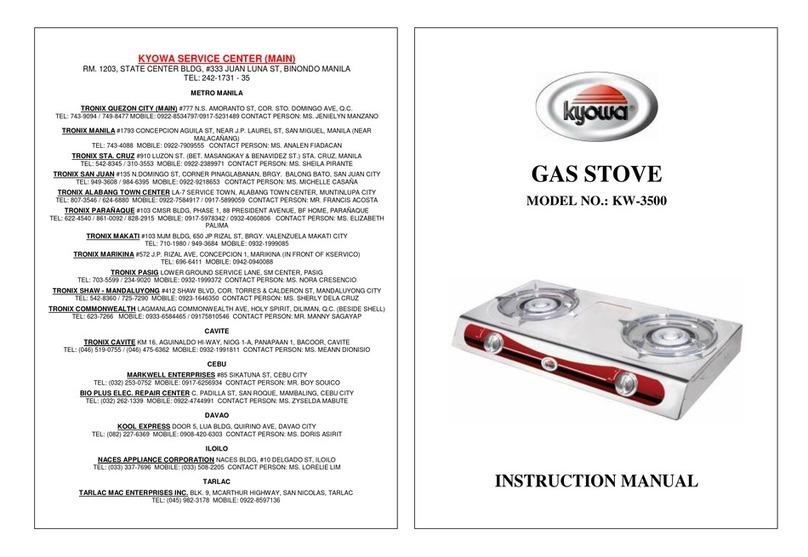Tim Sistem CAROBNA HYDRO User manual

CAROBNA HYDRO
Owners’s manual
INSTALATION, ADJUSTMENT AND OPERATING INSTRUCTION
EN 13240

1
Dear Customer,
We appreciate your trust on our product and decision to use "TIM SISTEM" product.
You have invested in energy-efficient and high-quality product –CAROBNA HYDRO wood burning
stove.
Your purchase will provide you long-term clean and comfortable heating with minimal maintenance.
Please read these instructions carefully and completely.
Its purpose is to inform you about the installation, operation and maintenance of your stove. Keep it
handy and refer to it as needed. You will find in it information that will be useful now and in the years
to come.
Make sure that when installing the stove all security standards have been respected and that all
water pipes, connections between tubes and pipes and walls are connected properly.
Failure to comply with these standards and carelessness during installation can result in damage to
property or put your health and life in danger!
Set your stove to a safe place, away from the frequent passages and doors, somewhere near
chimney and chimney connection.
We wish you many pleasant moments with CAROBNA HYDRO.
TIM SISTEM d.o.o.

CAROBNA HYDRO 2/ 20
Table of contents
WARNING BEFORE USE.........................................................................................................................................3
DESCRIPTION OF STOVE........................................................................................................................................4
INSTALING THE STOVE ..........................................................................................................................................6
IGNITION AND LIGHTING ......................................................................................................................................8
HANDLING STOVE OPERATION ............................................................................................................................9
I - regulation of secondary air.........................................................................................................................10
INSTALATION OF STOVE IN SYSTEM FOR CENTRAL HEATING.............................................................................10
Instalation on closed central heating system .................................................................................................11
InatLtion on the open central system.............................................................................................................12
CLEANING AND MEINTENANCE ..........................................................................................................................13
MALFUNCTION - RECOMMENDATION FOR ITS SLIMINATION............................................................................14
GENERAL RECOMENDATION...............................................................................................................................14
ADVICES FOR ENVIROMENT PROTECTION..........................................................................................................15
Packaging ........................................................................................................................................................15
Product............................................................................................................................................................15
DECLERATION OF GUARANTEE ..............................................................................Error! Bookmark not defined.

CAROBNA HYDRO 3/ 20
WARNING BEFORE USE
To keep your stove working properly, it is important to read this manual and strictly stick to the
instructions for use and handling.
For combustion use solid fuels such as wood and wood briquettes. It is forbidden putting explosive devices
and materials combustion chamber or the limited thermal furnace. It is forbidden to keep flammable
materials near the stove.
For proper combustion, in normal operating mode, draft in the chimney should be 12-15PA. If the draft is
greater than 17Pa, the valve should be installed in the chimney.
Room where the stove is positioned must be vented regularly for the fresh air needed for combustion.
Some parts of stove heat up during operation and it takes appropriate precaution when handling it. Do not
allow children to handle and play near the stove.
Only spare parts recommended and allowed by the manufacturer should be installed on the stove. You
must not make any changes on the stove.
With first firing there might show a mild smoke, especially from the plate’s surface. It is a common
appearance that occurs due to combustion deposits on the plate’s surface(corrosion protection, paint,
dust, ....). The room where the stove is should be vented during the first firing.
It’s not recommended connecting the stove to the common chimney because it can adversely affect the
required draft.
Device that uses gas as fuel must not be connected to same chimney.
During firing, use protection gloves because the door handles get heated.
National and local regulations for the installation of the furnace must be respected.
In a case of non-compliance with instructions given in this manual, manufacturer does not take any kind of
responsibility for caused damage.

CAROBNA HYDRO 4/ 20
DESCRIPTION OF STOVE
Wood burning stove CAROBNA HYDRO is manufactured and tested according to European standard EN
13240. Figure 1 shows the layout of the stove with integral parts essential for handling.
Wood burning stove CAROBNA HYDRO has a boiler (fig. 1, pos. 11) capacity of 10l, which is made of boiler
plate thickness prescribed standards. Such preparation increases the working life of the boiler. Connections
for water are 1“.
The upper plate of the fireplace is made of steel. (fig. 1, pos. 1)
Firebox doors (fig. 1, pos. 6) are made of steel with fireproof glass.
Connection for smoke drains being put on the plate and connected with screws. (fig. 1, pos 2.). and are made
of cast iron
All the materials that CAROBNA HYDRO stove is made can be recycled.
Sealing elements are made of materials that NOT contain asbestos.
The grid in the combustion chamber (fig. 1, pos. 8) is made of cast iron.
Integral parts of the stove:
1 –Upper (hot) plate
2 –Smoke exhaust
3 –Secondary air regulator
4 –Secondary air
5 –Door handle
6 –Fire door feat resistant glass
7 –Grid carrier
8 –Grid
9 –Primary air regulator
10 - Ash pan
11 - Boiler
Fig. 1. integral parts of the stove CAROBNA HYDRO

CAROBNA HYDRO 5/ 20
Technical data:
Name
ČAROBNA HYDRO
Use
Fireplace stove for heating
with integrated boiler
Nominal power [kW]
13,16
Nominal power given to water
7,12
Space heat output
6,04
Efficiency [%]
81,25
Fuel
Wood, wood briquettes
Dimensions of stove WxLxH [mm]
430x464x823
Dimension of the fireplace WxLxH [mm]
340x300x285
Weight [kg]
110
Minimum distance from flammable materials [mm]
Back
500
Side
500
Front
800
Content CO (reduced on 13% O2) [%]
0,091
Chimney connection [mm]
Ø120
Chimney connection position
Central on upper plate
Fuel consumption on nominal power [kg/h]
4,5
Emission temperature [°C]
247
Air regulation
Primary
Manual control
Secondary
Manual control
Boiler water capacity [l]
10
Required draft [Pa]
12-15
Hydro stove with back boiler are intended for heating residential space. An integral part of the installation is
a temperature safety relief valve for thermal discharge that serves as thermo safety of possible overheating.
It is recommended “ Caleffi 544 ½” shown in Figure 2
Fig 2.
Function:
Drain valve for thermal protection limits the water temperature. They
are intended for cooling of heating hot water when the temperature
reaches the limit of 95 C. If the probe is immersed in the hot water
outlet from the boiler registers the increase in temperature gives a
signal to open the valve to the cold water from the local installation
introduced into the system and cools it until the excess hot water goes
to the drain.
They are intended for installation in systems where it is not possible to
install the valve directly to the boiler body (not exist without heat
exchanger)

CAROBNA HYDRO 6/ 20
INSTALING THE STOVE
Stove must not be set up near the wooden parts, refrigeration devices, plastic furniture and other
flammable materials because during operation (during fuel combustion) it achieves high operating
temperature that is distributed on the outside of the furnace. Minimum distance between the stove and the
surrounding elements is 50 cm, and the from flammable materials 80 cm.
If the ground on which you set the stove is made of easily flammable material (wood, warm floor,
laminate ...) you need to set under the stove a protection sheet metal - lateral width of 10 cm and 50 cm in
the front.
Because of its weight, the stove must be installed on the appropriate base. If it does not satisfied
necessary standard, you must take appropriate measures to make it possible (e.g., weight distribution).
Connect the stove to a chimney and flue pipes through the connector on top of the furnace, so as to ensure
adequate tightness and flow of smoke from the stove to the chimney. Flue pipe must not be drawn too
deeply into the chimney that would reduce the cross sectional area and thus undermined draft in the
chimney. Do not use reducers which reduce the cross section of pipe smoke.
The stove requires insertion of fresh air in the room where it is installed, with surface openings for
insertion of fresh air should not be less than 0.4 dm ². The unit for fresh air set outside the common room for
ventilation, which must be insured by door and grids.
Fans that work in the same room where the stove is installed may make interference with stove. Also,
all devices or ventilation that creates negative pressure in the room where the stove is installed, must be set
in the way that does not make decompression that prevents normal operation of the furnace.
Before installing the stove, check the chimney drafts because it is a key factor in the proper functioning of the
stove. Draft depends on the proper operation of the chimney and meteorological conditions. One of the
easiest ways to check the draft in the chimney is with a candle flame, as shown in Figure 3 . Put a candle near
the chimney connection drain. If the flame bends towards drain, the draft is satisfying (Figure 3b). If the flame
doesn’t bend or bends a little, that indicates poor draft(Figure 3a).
If there is poor draft in the chimney (Figure 3a), check the chimney operation. The chimney should be
located inside the building, and if it’s located on the external walls of the building, it’s recommended
insulation chimney.
Fig. 3a. Fig. 3b.

CAROBNA HYDRO 7/ 20
Fig. 4.
Defaults of the chimney may be (Fig. 4):
1. Chimney is lower then top of the roof,small cross section of the exit
2. Too large slope
3. Abrupt alteration of the direction of smoke channel,
4. Stove or other device connected to the same smoke channel,
5. Bulges in the smoke channel,
6. Cranks,
7. Foreign body or deposited smut,
8. Too deep installed pipe,
9. Ventilator or other device which createssub-pressure in the room
10. Leaky or open aperture for cleaning

CAROBNA HYDRO 8/ 20
IGNITION AND LIGHTING
Before the first firing, wipe all painted surfaces with clean and dry cloth, in order to avoid burning impurity
on the oven and creation of unpleasant smells.
Start the fire in the stove by following order:
• open the fire door,
• place the fuel into the fire place (chopped wood to non-greasy wrinkled paper), and light a fire
• leave open primary air regulator (opposite of clockwise direction) until the flame gets stable and after
having stabilized the flame, control burning intensity with drafts regulator (Fig. 1, pos. 9)
• secondary air regulator leave opened until the flame gets stable and after
having stabilized the flame, control burning intensity with regulator (Fig. 1, poz.3)
• close the firebox door,
• after creating a basic flame insert larger pieces of wood or briquettes in the firebox, and
close the firebox door. If you use briquettes as a fuel, you must wait that all briquettes are lit and then
reduce the draft in half.
• when adding fuel, open the fire door (Fig. 1, pos. 4) step by step wait for 4-5 seconds, and then slowly
open it wide.
Do not open the door suddenly, when there’s a strong flame in the combustion chamber, it may come to its
spreading into the room.
Regulating the draft in the stove, you can regulate temperature, power and the combustion of fuel, and this
is done by running draft regulator on the firebox door (Fig. 1, pos. 11). Combining primary air regulator and
secondary air over the leverage above the firebox door (Fig. 1, pos. 3) you get desired combustion.
Stove contains auxiliary tools in order to facilitate its maintenance.
Recommended fuels are briquettes and wood.
You must not use gasoline and similar fuels, because by using liquid fuels you create conditions for damaging
the stove and to provoke an explosion.
Attention!
• Do not use organic wastes fuel, food residue, plastic, combustible or explosive materials, which combustion
disturbs the proper functioning of the stove and may cause damage and environmental pollution.
• Increased ambient temperature can cause poor air circulation (drafts) in the chimney, and in that case is
recommended more frequent firing in smaller quantities.
• Avoid using the stove when there are bad weather conditions for the stove andin the case of strong wind,
because it reflects the required vacuum in the chimney. In these cases there may occure potential return of
smoke in the room where the stove is placed. Ignition is difficult then.
We recommend firing every hour with the amount of fuel in the combustion chamber up to 15cm with cross
stacking wood for better airflow.
After each refilling, it’s reccomender to leave the oven running in full speed for 30 minutes,in order to
destroy all volatile elements that may cause condesation in the stove.
For proper operation of the stove it is nesessary:
- Regular cleaning of stove and chimney
- Regular room ventilation or better combustion
- Regular ash tray cleaning
- Accumulated slag and unburned material regularly remove from the grid

CAROBNA HYDRO 9/ 20
HANDLING STOVE OPERATION
- Start a fire with a moderate flame in order to avoid thermal shocks.
- The following amounts of wood are inserted only after the previous volume burn. Do not allow that ashes
and unburned accumulate on the grid and top of it that way. Clean the grid.
- Open the door slowly and carefully, allowing that way equalization of pressure in the firebox and in the
room, otherwise it might cause the smoke in the room.
- The stove is designed and intended for use with firebox door constantly closed, except during refueling. Do
not open the door with no need.
The wood must be a maximum of 20% moisture content for maximum fire effect. Otherwise the tar
gets separated which with water steam may crate creosote. If that happens in some bigger quantity, it may
lead to a chimney fire. You will most easily recognize chimney fire by: the characteristic sound that comes out
of the chimney like loud roaring, visible flames coming out of the chimney, high ambient temperatures of
surrounding walls and the characteristic smell of burning.
If there comes to the fire do the following:
• Immediately call the fire squad
• muffle oxygen supply to the chimney and turn off the stove
• Do not insert anything into the chimney and make sure that the fire does not spread to the wooden
construction or other combustible materials in its nearby.
• DO NOT pour water into the stove or chimney
• A fire in the chimney can be extinct only with dry powder
• Water can extinguish only a surrounding material
• Do not cool the surrounding walls with water
Note:
If the fire in the stove for some reason becomes dangerously strong take the following measures: close air
dampers that provide air for combustion. If it is necessary put in the firebox specially prepared sand for this
purpose or non-combustible fire blanket. It would be good to have a fire extinguisher.
Before the second charging, clean the grid in order to provide the fresh air.
Regularly clean the ash pan making sure that there is always a place for ashes.
The stove is designed to operate in periodic mode. To maintain the required nominal power, combustion
chamber is periodically filled with reestablished amount of fuel.
Stove is not designed to operate in continuous mode of heating or in accumulating temperature mode.

CAROBNA HYDRO 10/ 20
I - regulation of secondary air
Set the secondary air in the closed position during firing and kept in this position until the establishment of
the working regime of burning after insertion of larger pieces of wood. After this time set the controller in
position open and hold it in this position all the time stove functioning. The secondary air is used to clean the
glass (air wash) on the firebox door and for better combustion.
Power regulation is the furnace is obtained by adjusting the regulator of the primary and secondary air
open closed
INSTALATION OF STOVE IN SYSTEM FOR CENTRAL HEATING
- For water inlet and outlet within the system of floor (central) heating are provided with adapters on boiler
1".
- Stove may be mounted on closed or open system of central heating.
For pressure pipe set user must have:
- Temperature and pressure gauge to indicate the pressure in the water system and the water temperature
at the boiler outlet.
- Safety valve (which opens at a water pressure of 2.5 bar) to put on the discharge pipe immediately behind
the boiler. The output of the safety valve should be carried out in the sewer.
- Union coupling , for easy assembly and disassembly in case of repairs.
On the return line is necessary to put:
- Filling and emptying installations
- Union coupling, for easy assembly and disassembly in case of repairs.
At the beginning of its operation it is necessary that:
- The stove should be connected to the chimney
- Installation must be filled with water (at a pressure of 1-1.5 bar), and the whole system vented.
- It is necessary that all the valves between the stove and installation are open
Note: Installation of heating and commissioning of the entire system should be entrusted to professional
person who guarantees the correct operation of the entire heating system. In case of bad design of the
system and possible failure in execution of works by that person, complete material solely the responsibility
of the person to whom it is entrusted installation of heating systems, not the manufacturer, of the boiler.
Important!
Installing the stove should be performed expertly face at a reasonable project. The design allows you to
connect the stove to an indoor or outdoor heating system. All connections must be well sealed and fastened.
Prior to commissioning, a complete installation shall be tested with water at a pressure of 3 bar.

CAROBNA HYDRO 11/ 20
When installing a safety valve pay attention to the direct connection to water supply and sanitation, as well
as the fact that the valves (taps) must always be open
Note: The installation of heating and commissioning of the entire system should be entrusted exclusively
technician who guarantee the correct operation of the entire heating system. In case of bad design of the
system and possible mistakes while works by such person, a complete financial responsibility shall be borne
solely by that person entrusted with the installation of heating systems, not manufacturer or of the boiler.
Important!
Installing the stove needs to be executed expertly face at a reasonable project. Construction of the stove
allows you to connect to the closed or opened heating system. All connections must be well sealed and
fastened. Prior to commissioning, the complete installation must be tested with water at a pressure of 3 bar.
When installing a safety valve pay attention to the direct connection to water, sewer, and that valves
(faucets) should always be open.
It is required the installation of a four-way mixing valve at certain place (Figure 7a and 8a) or a tubing pipe
contact thermostat (Figure 7b and 8b), set to 55 ° C. Their installation is required for the prevention of
condensation on the walls of the boiler in the furnace (condensation boiler adversely affect the service life of
the boiler and on the performance of the product by creating a resin on the walls of the boiler, which
represents an insulator so the product does not have declared characteristics).
Instalation on closed central heating system
One of the aspects of mounting installations is depicted on figure 7a.and 7b.
- Safety valve must be installed in the vicinity of boiler and must be adjusted for pressure of max. 3 bar.
External guide of safety valve must be as shorter as possible and may not have possibility to be closed.
Within this guide, also, there may not be single valve or any other armature.
- Closed expansion vessel is to be mounted in the vicinity of boiler and its safety guide is short. Volume of this
vessel is determined according to the capacity of boiler and regarding ratio 1kW:1l.
- Installation of thermal valve in its provided place on the boiler is mandatory. We recommend thermal valve
Caleffi 544
Figure 7 a –Scheme of closed central heating system with built in 4-way valve

CAROBNA HYDRO 12/ 20
Figure 7 b –Scheme of closed central heating system with built leaning pipe thermostat
Pump 1. Intake valve
Valve 2. Guide for filling and discharging the system
Air-exhaust valve 3. Distribution guide
Safety valve 4. Thermal exhaust valve
Mixing valve 5. Drainage for overheated water from the system
Thermomanometer 6. Aqueduct network
Consumer 7. Closed expansion vessel
Boiler filling tap 8. Leaning pipe thermostat
Instalation on the open central system
One of the aspects of installation is depicted on Figure 8a and 8b.
At this system, starting guides are to be mounted in sequence, safety distribution guide of expansion vessel
and boiler valve, and on starting guide of the system boiler valve, pump and valve are to be installed. Directly
below opened expansion vessel, short connection should be installed between safety distribution guide and
safety retracting guide, which provides freezing of water during winter in the expansion vessel.
On safety distribution and safety retracted guide, there may not be any armature. Expansion vessel itself
must possess overflow pipe as seen on scheme on figure 6. Volume of expansion vessel is determined by the
pattern:
V = 0,07x V water, (l), where V water is volume of water in entire power plant.
Open expansion vessel is to be installed vertically above the highest heating body. At the opened system of
heating, gravitation system of heating is possible.
Thermal safety valve, Caleffi 544, in installation for open central heating system is not necessary.

CAROBNA HYDRO 13/ 20
Figure 8 a –Scheme of closed central heating system
with built in 4-way valve
Figure 8 b –Scheme of closed central heating system
with built leaning pipe thermostat
CLEANING AND MAINTENANCE
Regular and proper cleaning allows proper operation and long life of the stove. All cleaning the interior or
exterior surfaces are always performed in a cold oven.
Cleaning exterior surfaces - is done with a soft cloth that will not damage the surface of the stove. Cleaners
of chemical origin can damage the surface of the fire place and cannot be used. Painted surfaces must not be
cleaned with abrasive products.
Cleaning inter surfaces –when cleaning use protective gloves.
Clean the bottom of the fire chamber from accumulated ash and pick up small unburned pieces of the grid,
clean the ashtray and ash accumulated in the interior of the fireplace.
Cleaning glass surfaces - glass on the firebox may get dirty during the operation.. For cleaning use a mild
detergent. Do not use abrasive cleaners because they can damage the surface of the glass. Clean the glass
only when cool.
Cleaning and maintenance of the chimney - chimney cleaning and control is recommended at least once a
year and after a long downtime. Regular maintenance and control of the chimney will prevent the
occurrence of fire and poor operation of the stow.

CAROBNA HYDRO 14/ 20
MALFUNCTION - RECOMMENDATION FOR ITS SLIMINATION
The following table shows the most common defects and recommendations for their removal.
Table: Showing the most common malfunctions, possible causes and ways of eliminating it.
Malfunction
Possible cause
Howe to remove it
Oven heats poorly
improper handling,
Poor uptake
Read carefully and follow the instructions.
In the case that despite all instructions have been
respected, malfunctions are still not removed, call the
customer service
Difficulties in lighting
fire
Closed regulator of air supply,
Wet wood,
Lack of oxygen
Open the regulator of air supply and provide a supply of a
primary air
Use a dry wood
Ventilate a room in order to provide a supply of fresh air
Smoke reenters into a
room
Closed regulator of air supply,
Insufficient draft,
Remaining of ashes on a grid
Open the regulator of air supply and provide a supply of a
primary air
Read carefully the instructions and apply advices how to
provide a draft
Clean the grid
Glass on a firebox door
are getting sooty for a
while
Wet wood
Too much fuel
Insufficient draft
Closed intake of secondary air
Use a dry wood
Check a suggested quantity of a fuel provided in a user’s
manual
Check a connection with a chimney
Read carefully the instructions and apply advices how to
provide secondary air
Not enough heat in
radiators
Air in installation
Power of radiators exceeded
power of boiler
Improper using
Vent the radiators
from the heating system, turn off some of heating body
Read carefully the instructions for using and maintenance
GENERAL RECOMENDATION
If you have full field all the recommendations for installation, operation and control of cleaning, given in this
manual, the stove is now tested, safe device for household use.
Before installing the stove, remove the package. Be aware of potential injuries because the wooden slats are
connected with nails. Dispose a plastic bag in accordance with the regulations. Old stove you do not want to
use anymore, dispose to designated areas in accordance with the regulations.
All complaints, perceived failure or malfunctioning stoves, should be reported to the factory or authorized
service center by telephone or in written, only with fiscal receipt. All contact information provided at the end
of this guide.
Any malfunction of the stove, must be removed by the manufacturer’s service only.
If unauthorized persons carry out any servicing or repairs and alterations to the stove, the owner loses the
right to the manufacturer's warranty.
Supply of spare parts has to be done via manufacturer's service, based on the position and image of this
manual.
The manufacturer does not assume any responsibility if the buyer fails to comply with the instructions for
use and installation of the stove.

CAROBNA HYDRO 15/ 20
ADVICES FOR ENVIROMENT PROTECTION
Packaging
Packaging material is 100% recyclable.
For a waste disposal of, act in accordance with local regulations.
Packaging material (plastic bags, polystyrene parts-polystyrene, etc.). Should be kept away from children, as
a potential source of danger.
Take care of safe removing and disposing of wooden boards because they are connected with nails.
Product
The device is made of materials that can be recycled. When disposing the waste, act in accordance with
environmental laws in effect.
Use only the recommended fuel.
It is forbidden burning an inorganic and organic materials (plastics, plywood, textile, oiled wood, etc..),
because the combustion releases carcinogenic materials and other toxics.

CAROBNA HYDRO 16/ 20
WOOD BURNING STOVE CAROBNA HYDRO

CAROBNA HYDRO 17/ 20
The list of position in CAROBNA HYDRO stove:
1 Flue gases connector
2 Top panel
3 Outer stove Corpus
4 Inner stove Corpus
5 Boiler assembly
6 Deflector
7 The carrier grid
8 Wire for spreading
9 Bottom stove
10 Grid
11 Ashtray
12 Wrench
13 Bracket cup assembly
14 Door handle
15 Washer door handles
16 Primary regulator
17 Glass doors
18 Door
19 Pin
20 Decorative panel
21 Front furnace
22 Secondary air regulator
23 Screw nut

CAROBNA HYDRO 18/ 20
STOVE DIMENSION

19
TIM SISTEM d.o.o.
ul. Prva industrijska 9
22330 Nova Pazova, Serbia
Tel/fax: +381 22 328 076
e-mail: office@timsistem.rs
www.timsistem.rs
Table of contents
Other Tim Sistem Stove manuals
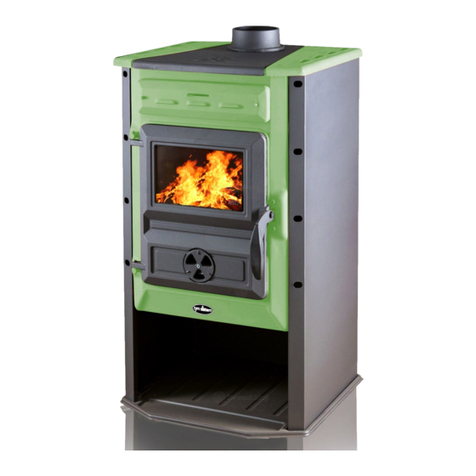
Tim Sistem
Tim Sistem CAROBNA PEC User manual
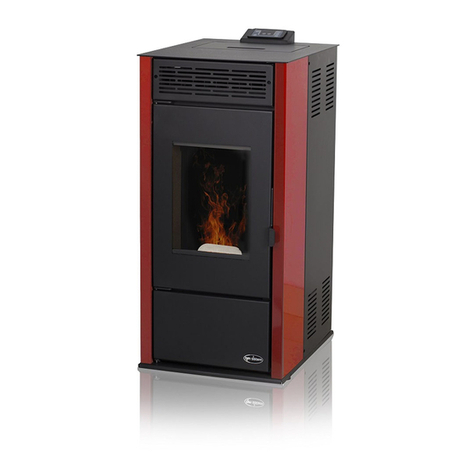
Tim Sistem
Tim Sistem RITTIUM 6 User manual
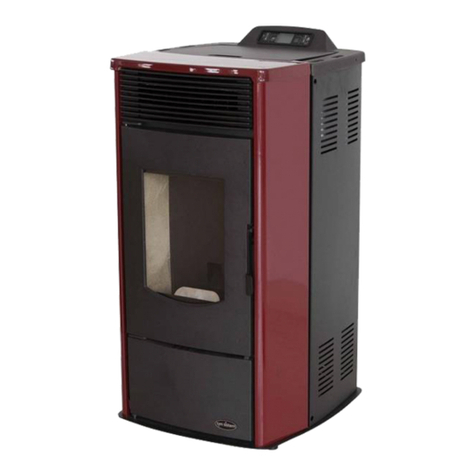
Tim Sistem
Tim Sistem RITTIUM CTP User manual
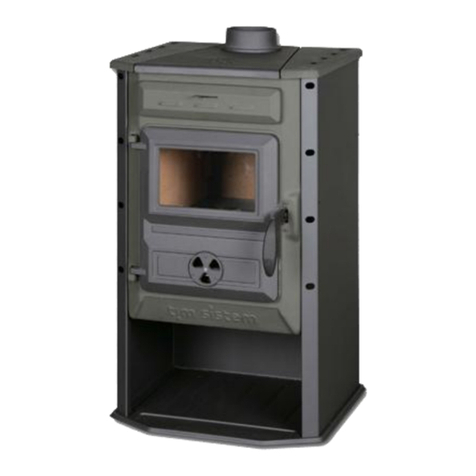
Tim Sistem
Tim Sistem Magic User manual
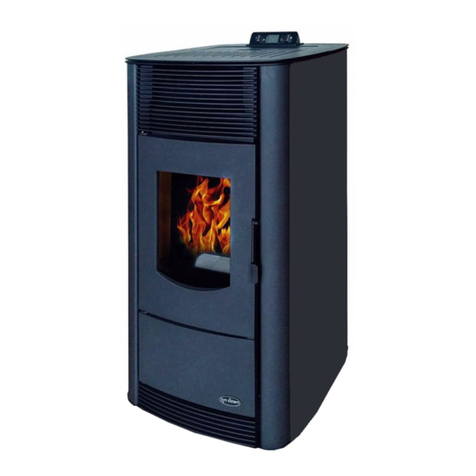
Tim Sistem
Tim Sistem Rittium 14 User guide
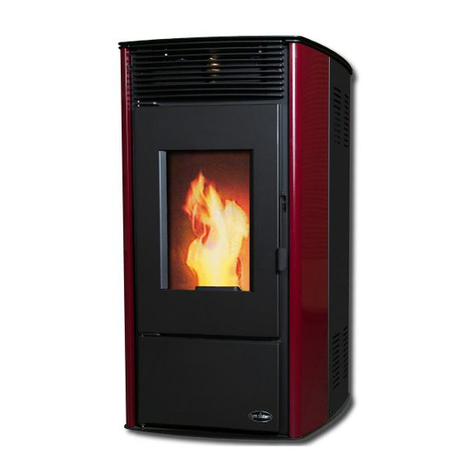
Tim Sistem
Tim Sistem rittium 14 hydro User manual
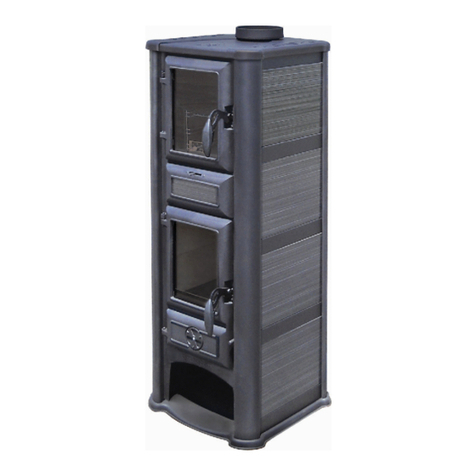
Tim Sistem
Tim Sistem LEDERATA PLUS User manual
Popular Stove manuals by other brands

Broseley
Broseley WINCHESTER Installation and operation manual

Morso
Morso S81-90 Instructions for installation and use

Palazzetti
Palazzetti ECOPALEX T Glass Installation, user and maintenance manual
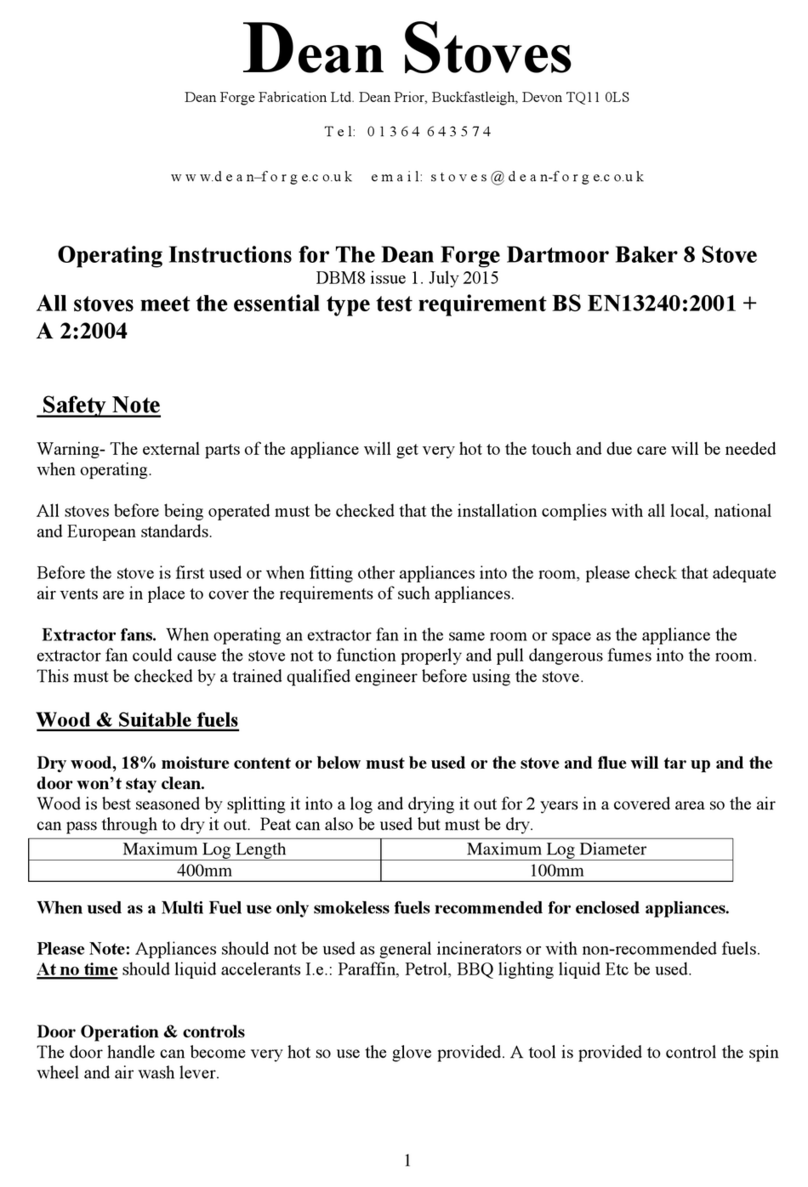
Dean Forge
Dean Forge Dartmoor Baker 8 operating instructions
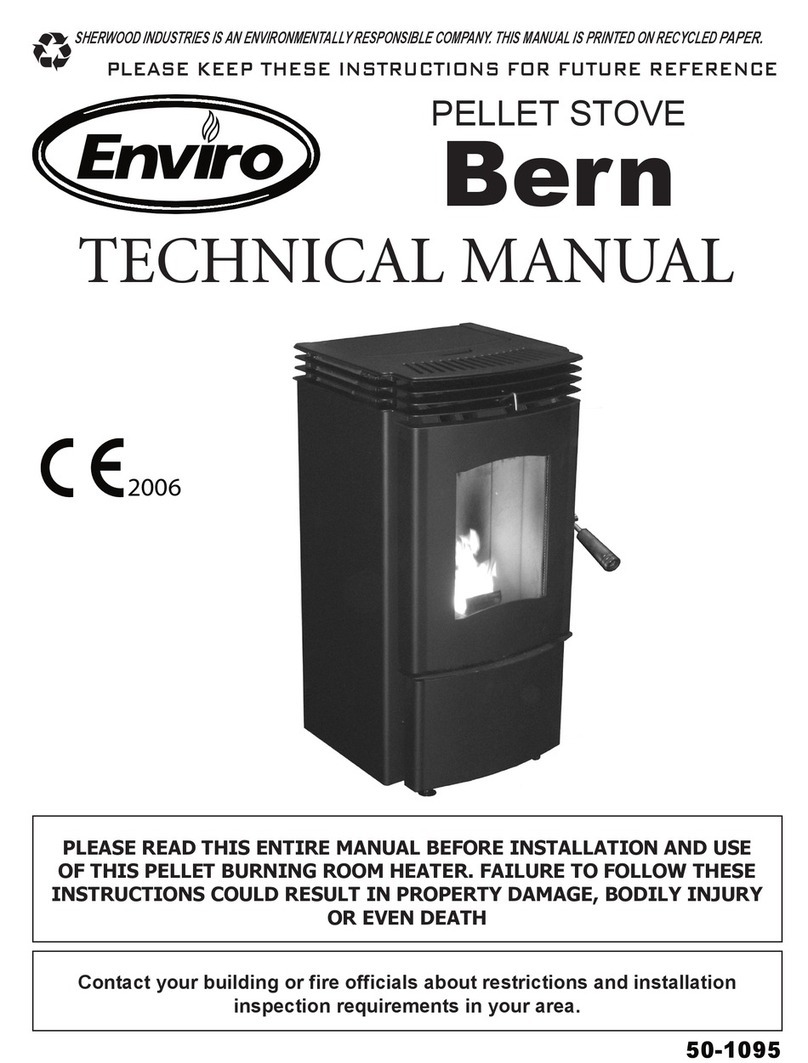
Enviro
Enviro 50-1095 Technical manual

RIKA
RIKA LOOK Assembly manual
